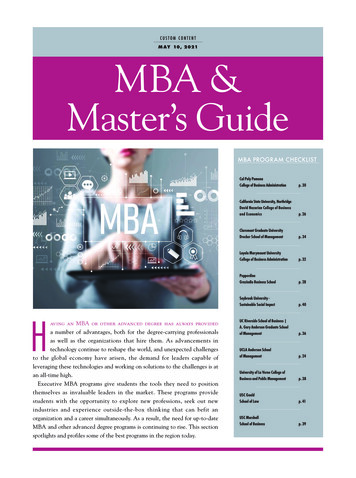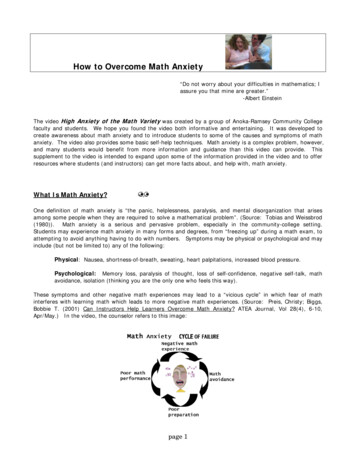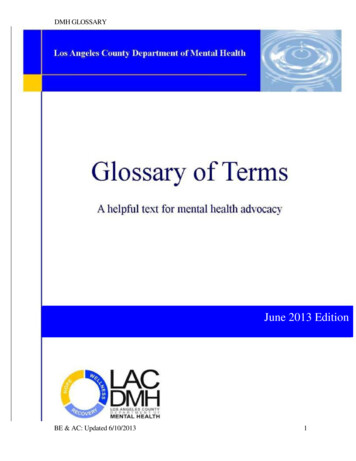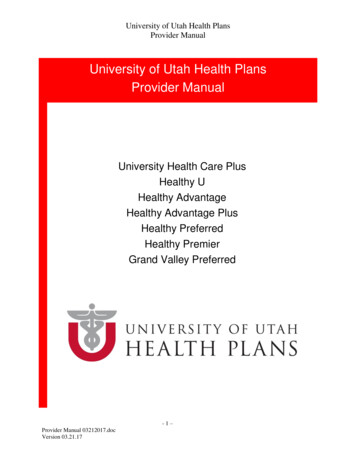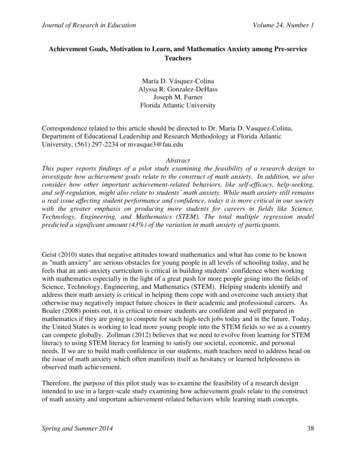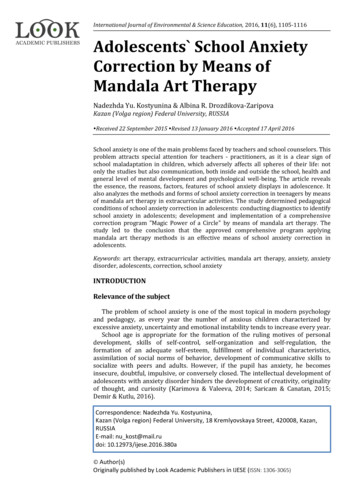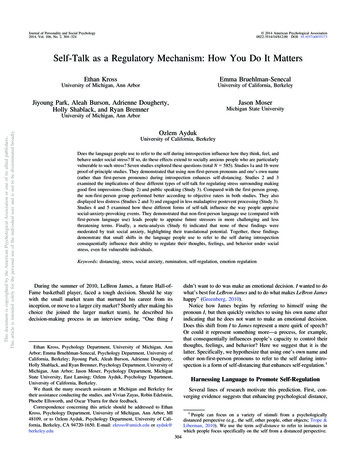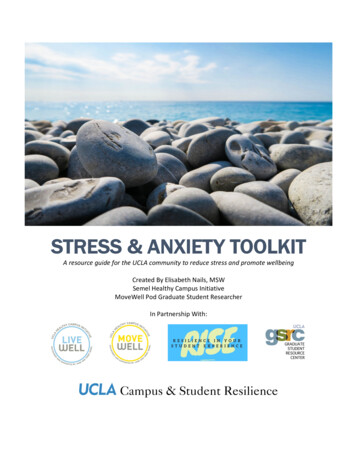
Transcription
STRESS & ANXIETY TOOLKITA resource guide for the UCLA community to reduce stress and promote wellbeingCreated By Elisabeth Nails, MSWSemel Healthy Campus InitiativeMoveWell Pod Graduate Student ResearcherIn Partnership With:
Stress & Anxiety ToolkitTABLE OF CONTENTSTITLE PAGE .1TABLE OF CONTENTS . .2OVERVIEW . .5BACKGROUND OF PROJECT . . . .5PURPOSE . . . .6IMPACT . . .7FRAMING—SUGGESTED LANGUAGE AND APPROACH . .12SAMPLE WORKSHOP PLANS .14DESCRIPTION OF ACTIVITIES AND FACILIATION GUIDE . . .16WELCOME CIRCLE . . . . 16Warm-up #1: Name/Pronouns/Fruit Gesture & Repeat (5-6 minutes) .16Warm-up #2: Pass the Stress Ball (5 minute). . . . .16Activity A: Group Discussion: What is Stress & Anxiety? (15-20 minutes) . .17Activity B: Co-Define Stress & Anxiety (7 minutes) . 18Activity C: Introduce Stress & Anxiety Toolkit/Resilience Framework (5-7 minutes) .19Activity D: What is in your toolkit? Exploration and Share-out (10 minutes) .19Activity E: Explore Arts-Based Toolkit Methods . . .20GROUP GAMES/PLAYE.1 What’s one thing in your toolkit? (5-7 minutes) .20E.2 Send the Clap around the Circle (5-8 minutes) . .202
Stress & Anxiety ToolkitEGG SHAKERSE.3 Pass the Shake (5 minutes) . .21E.4 Simple 2 minute timed egg shake meditation (3 minutes) . 21DANCE SCARVESE.5 Basic Dance Scarves Games (10-15 minutes) . 22E.6 Dance Scarves—Group Dancing (3-5 minutes) . . 22MINDFUL DRAWINGE.7 Crumple Sheet Drawing Meditation (5-7 minutes) . .23E.8 Recipe Cards for Stress Management (10 minutes) .23E.9 Affirmation Cards (10 minutes) . .23E.10 Worry Strips (10 minutes) . .23E.11 Two-Sided Sheet: Worries/Alternative Thoughts (10 minutes) .24E.12 Hand Trace Gratitude Mediation (10 minutes) . . .24GRATITUDE PRACTICESE.13 Awe Activity (20-30 minutes) . 24MOVEMENT PRACTICESE.14 Brain Dance (Developed by Anne Green Gilbert) (7-10 minutes) . .25MINDFUL MEDITATIONSE.15 Self-Compassion Guided Meditations . 26E.16 Self-Compassion Break (5 minutes) . 26E.17 Mountain Meditation (10 minutes) . . 26E.18 Grounding (5 minutes) . .263
Stress & Anxiety ToolkitE.19 STOP technique (3-4 minutes) .26E.20 MELT technique (3-4 minutes) .27CLOSING CIRCLEE.21 Gallery Walk (10-20 minutes) .27E.22 Group Discussion (5-10 minutes) . .27E.23 Closing One Word or One Sentence (5 minutes) . . .27RESOURCES . . .28SURVEY TEMPLATE . .294
Stress & Anxiety ToolkitThe mind is like the wind and the body like the sand; if you want to know which way the wind isblowing, you can look at the sand. Bonnie Bainbridge CohenOverviewWhat is a Stress & Anxiety Toolkit?A resource guide for the UCLA community to reduce stress and promote wellbeing.Most everybody experiences stress and anxiety to varying degrees. Each individual carriesresources and knowledge to manage day-to-day experiences. These resources and knowledgehave been shaped on the individual level by family, friends, mentors, and on a community levelvia culture, environments, and by the various systems which an individual interacts.There are countless resources and practices that humans engage in to manage everyday stressand anxiety. This toolkit recognizes that each participant carries their own forms of knowledgeand are the experts of their own lives. The toolkit presents a collection of practices andresources and seeks to inspire participants to gain a sense of their existing personal toolkits,and to further cultivate their toolkits through ongoing intentional practice.The workshop is shaped by an empowerment approach that is: Strengths-based Arts and healing-informed Trauma-informed Focused on nurturing and celebrating resilienceBackground of ProjectThe Stress & Anxiety Toolkit was developed as a project by the UCLA Semel Healthy CampusInitiative’s MoveWell pod’s graduate student researcher (GSR) Elisabeth Nails (UCLA MSW,2019) with significant input by pod leader Angelia Leung and undergraduate student researcherTracy Lahey, as well as from Allyson Pimentel, Director of UCLA Campus and Student Resilience.The MoveWell pod works closely with UCLA Recreation to expand and “co-brand” physicalactivities both within and beyond the John Wooden Center and associated recreationalfacilities, with the aim of making movement “the easy healthy choice” for the UCLA community.Starting in 2013 MoveWell GSR Sarah Wilbur saw a need for stress-reduction efforts amongstgraduate students campus-wide. MoveWell partnered with the Graduate Student ResourceCenter (GSRC) to develop movement-based workshops to address stress-reduction titled“Writing Ergonomics” and “Fitting Fitness In”. Pod Leader Angelia Leung and GSR’s Ellen Gerdesand Vanessa Perez continued GSRC partnership and expanded to UCLA Center for theAdvancement of Teaching’s TA Training Program. In 2017 GSR Elisabeth Nails met with5
Stress & Anxiety Toolkitstakeholders to assess needs. It was determined that an arts-based and movement-basedapproach to reducing stress and anxiety would be beneficial to pilot. The original workshopswere adapted to include training for TA’s and a new arts-based Stress & Anxiety Toolkitcomponent. The workshop was piloted at the TA Training Conference in Fall 2017 and hassteadily expanded.UCLA Campus Partners UCLA Center for the Advancement of Teaching (formerly OID) TA Training Program UCLA Graduate Resource Center UCLA Office of Campus and Student Resilience UCLA RISE (Resilience in Your Student Experience) UCLA Mindful UCLA Counseling & Psychological Services UCLA Department of World Arts & Cultures/Dance UCLA Fielding School of Public Health UCLA Herb Alpert School of Music UCLA Luskin School of Public Affairs, Department of Social Welfare UCLA Center for Arts & HealingCommunity Partners New Heights Charter School, South Los Angeles Violence Intervention Program-Community Mental Health Center, Boyle Heights Gratts Early Education Center, Downtown Los Angeles Castelar Street Early Education Center, ChinatownPurposeThe following Stress & Anxiety Toolkit is intended to be harnessed as a resource by anyindividual or group seeking to engage in conversations about stress, anxiety, and resilience. Thetoolkit contains sample workshop plans, descriptions of additional activities, resources, samplesurveys, and language to assist facilitators in framing their approaches to the topic. You arewelcome to implement the toolkit as a full program, adapt portions of it, and/or use it as aguide in creating a program of your own. All of the wisdom in the toolkit comes from my ownlived experience, lessons learned from piloting the workshop over the last two years, and frompractices passed along by my teachers, mentors, peers and clients. In this sense, I see it as aliving document that should be adapted to serve a multitude of contexts.ImpactOver the last two years MoveWell has facilitated 12 on-campus Stress & Anxiety ToolkitWorkshops for a total of 473 Participants: 382 Graduate Students (North & South Campus), 65Undergraduates (Vocal/Opera Program), and 26 Staff and Faculty. An additional 504participants were reached via community workshops in Boyle Heights, South Los Angeles,Downtown, and Chinatown.6
Stress & Anxiety ToolkitThanks to partnerships with UCLA’s TA Training Program, the Graduate Student ResourceCenter, and RISE the workshops reached a broad spectrum of participants from diverse fields ofstudy including: sChemistryCommunity Health SciencesComputer SciencesEcology & EvolutionElectrical & Computer EngineeringEnglishEpidemiology Gender StudiesGeographyLawMolecular BiologyMusicMusic PerformanceNew GenresNursingPolitical ScienceSocial WelfareStructural BiologyTheatreThe following presents tables that summarize data collected from 2018-19 post-workshopsurveys.7
Stress & Anxiety Toolkit8
Stress & Anxiety Toolkit9
Stress & Anxiety Toolkit10
Stress & Anxiety ToolkitThe survey data highlights the impact this workshop intervention typically has on a majority ofparticipants including: Expanded self-awareness about one’s own stress and anxietyExposure to helpful tools to manage stress and anxietyIncreased understanding of the impact of stressDeepened understanding about how to support colleagues, students and friends whomay be experiencing stress and anxietyIn post-workshop evaluations a majority of participants reported: They feel prepared to use the tools introduced for personal stress management They are extremely likely to attend a follow-up coaching session They feel comfortable advocating for incorporating any of the tools into class sessions ormeetings11
Stress & Anxiety ToolkitFraming—Suggested Language and ApproachThe following offers suggested talking points to open up conversations about Stress & Anxietyas well as resilience. I have generally adapted this text as an introduction to the workshop andto frame the approach. Much of the following is inspired by the work of Dr. Lisa Damour, authorof Under Pressure.1As I provide this suggested text, I will also disclose my positionality as a cis-gender whitewoman. My lived experiences and the assumptions and conclusions I have drawn from themare my own and are shaped by my identity. Stress and Anxiety impact individuals and groups ina number of ways. One person’s truth may not translate to another person’s lived experienceor context. It is important to acknowledge that other considerations such as culture, socialeconomic status, race, age, and other factors may impact the way individuals or groupsexperience stress and anxiety, and may also reduce or increase barriers to resources for anindividual. If questions emerge for you as you engage with this language, I encourage you toinvestigate their insights. It may be useful to include any questions or ideas that emerge intoyour own language and framing. Also, as facilitator I encourage you to acknowledge your ownpositionality, and to honor the individual and collective knowledge of workshop participants inthe room as you invite them to discuss, expand and re-write the conversation as needed.What is stress and anxiety? There seem to be some misconceptions in United States pop culture about stress andanxiety. We seem to look at every variety of stress and anxiety and see it as pathological, and“BAD”. However, anxiety up to a point is a totally normal and protective function. Stress up to a point is a totally healthy and productive function. No distinction is being made between a really anxious moment and pathological anxietyAnd that may be creating way more stress and anxiety than is necessary and depletingour ability to recognize our own wisdom and resilience to manage day-to-day stress andanxiety. So much of the stress and anxiety that happens in the day-to-day falls into themanageable range, but many are forgetting that they have capacity and knowledge tomanage.1Damour, L. (2019). Under pressure: Confronting the epidemic of stress and anxiety in girls. Ballentine Books, NewYork. https://www.drlisadamour.com/under-pressure/12
Stress & Anxiety ToolkitDefinitionsAnxiety: an alarm system that alerts us that something is amiss. It becomes a mental healthconcern when the alarm system is not working properly, when it is ringing all the time inresponse to nothing or minor concerns, or it is blaring over something that should bemanageableStress: in its manageable forms, is any experience of change, anything that requires adaptation,stress comes with change (positive and negative).Stress & Anxiety can be capacity building: This means that when people go through a difficultexperience, the upshot is that they are potentially more durable because the experience hasexpanded their capacities for dealing with difficulty.Resources: What resources does a person have on-hand to manage day-to-day stress andanxiety and not feel overwhelmed by it?Recovery: Healthy functioning and sustainability are directly tied to RECOVERY.It’s all about recovery. Consider lifting weights. You can’t lift nonstop without major injury. Youhave to have periods of rest and recovery.Life is often is full of conditions that make individuals feel like they are “lifting weights” forextended periods of time. It is important to think through our day-to-day expectations andmake sure there are opportunities for rest and recovery (individually and collectively).It may be helpful to keep in mind 3 categories for stressors:Things we likeThings we can handleThings that are crisisBuilding up your individual toolkit can help you get more in touch with when and how stressand anxiety are showing up, and raising awareness about your own need for recovery.Ultimately, the goal of the toolkit is to help you handle more things and not plunge into crisis.13
Stress & Anxiety ToolkitStress & Anxiety Toolkit Sample Workshop Plans(2-3 hours are recommended, but workshop can be adapted to 90 and 60 minutes)The following are suggested sequences for workshops. Please feel free to mix and matchactivities, experiment, and adapt as you see fit. I encourage you to be creative and attuned toyour workshop participants as you create your own plans.Full Workshop Outline (3 Hours) Welcome Circle Warm-up #1: Name/Pronouns/Fruit Gesture & Repeat (5-6 minutes) Warm-up #2: Pass the Stress Ball (5 minutes) Activity A: Group Discussion: What is Stress & Anxiety? (15-20 minutes) Activity B: Co-Define Stress & Anxiety (7 minutes) Activity C: Introduce Stress & Anxiety Toolkit/Resilience Framework (5-7 minutes) Activity D: What is in your toolkit? Exploration and Share-out (10 minutes) E.1 What’s one thing in your toolkit? (5-7 minutes) E.3 Pass the Shake (5 minutes) E.4 Simple 2 Minute Timed Egg Shake Meditation (3 minutes) E.5 Basic Dance Scarves Games (10-15 minutes) E.6 Dance Scarves—Group Dancing (3-5 minutes) E.7-12 Participant Choice (30 minutes)Introduce activities and allow participants to pick at least 2-3:E.7 Crumple Sheet Drawing MeditationE.8 Recipe Cards for Stress ManagementE.9 Affirmation CardsE.10 Worry StripsE.11 Two-Sided Sheet: Worries/Alternative ThoughtsE.12 Hand Trace Gratitude Mediation E.13 Awe Activity (20-30 minutes) E.18 Grounding (5 minutes) E.20 MELT technique (3-4 minutes) E.21 Gallery Walk (10 minutes) E.22 Group Discussion (5-10 minutes) E.23 Closing One Word or One Sentence (5 minutes) Post-workshop survey2-Hour Workshop Welcome Circle Warm-up #1: Name/Pronouns/Fruit Gesture & Repeat (5-6 minutes) Warm-up #2: Pass the Stress Ball (5 minutes) Activity A: Group Discussion: What is Stress & Anxiety? (15-20 minutes) Activity C: Introduce Stress & Anxiety Toolkit/Resilience Framework (5-7 minutes) Activity D: What is in your toolkit? Exploration and Share-out (10 minutes)14
Stress & Anxiety Toolkit E.2 Send the Clap around the Circle (5-8 minutes)E.3 Pass the Shake (5 minutes)E.7 Crumple Sheet Drawing Meditation (5-7 minutes)E.9 Affirmation Cards (10 minutes)E.13 Awe Activity (20-30 minutes)E.18 Grounding (5 minutes)E.20 MELT technique (3-4 minutes)E.22 Group Discussion (5-10 minutes)E.23 Closing One Word or One Sentence (5 minutes)Post-workshop survey90-minute Workshop Welcome Circle Warm-up #1: Name/Pronouns/Fruit Gesture & Repeat (5-6 minutes) Activity A: Group Discussion: What is Stress & Anxiety? (15-20 minutes) Activity C: Introduce Stress & Anxiety Toolkit/Resilience Framework (5-7 minutes) Activity D: What is in your toolkit? Exploration and Share-out (10 minutes) E.2 Send the Clap around the Circle (5-8 minutes) E.5 Basic Dance Scarves Games (10-15 minutes) E.7 Crumple Sheet Drawing Meditation (5-7 minutes) E.12 Hand Trace Gratitude Mediation (10 minutes) E.18 Grounding (5 minutes) E.23 Closing One Word or One Sentence (5 minutes) Post-workshop survey60-minute Workshop Welcome Circle Warm-up #2: Pass the Stress Ball (5 minutes) Activity B: Co-Define Stress & Anxiety (7 minutes) Activity C: Introduce Stress & Anxiety Toolkit/Resilience Framework (5-7 minutes) E.1 What’s one thing in your toolkit? (5-7 minutes) E.10 Worry Strips (10 minutes) E.14 Brain Dance (7-10 minutes) E.16 Self-Compassion Break (5 minutes) E.23 Closing One Word or One Sentence (5 minutes) Post-workshop survey15
Stress & Anxiety ToolkitDESCRIPTION OF ACTIVITIES & FACILITATION GUIDEWelcome Circle (2 minutes)It is recommended that you start and close each workshop with a circle to promote a feeling ofconnectedness and to allow everyone to see one another.I often ask participants to take a few breaths to arrive and feel their feet on the ground andtheir bodies in the space (i.e. the workshop room) and to try and let go of any worries on theirminds. Sometimes I transition and invite the group to try and take three breaths all togetherusing only their 5 senses and no body language or spoken words.Warm-up #1: Name/Pronouns/Fruit Gesture & Repeat (5-6 minutes)Purpose: Supports basic introductions, introduces the idea of “play”, and social connection.Invite participants to go around the circle one by one and share with the group their name,gender pronoun, as well as name a fruit they like and share a gesture for the fruit. A gesture isa simple movement that describes the feeling or experience of a thing using body language.Oftentimes people naturally begin to add sounds to their gesture and that often makes it evenmore fun.*Note: I always kick this activity off by going first and demonstrating what it could look like.I invite the group to repeat the fruit and gesture together as a group.For example:Facilitator: “My name is Liz, my pronouns are she/hers and I like grapes (shares a gesture ofeating grapes off of a bunch like a queen).Group: “Grapes” (and everyone repeats the gesture Liz created)Warm-up #2: Pass the Stress Ball (5 minutes)Purpose: Invites limbic system calming through play and allows for individual self-expression, tobe seen and heard. It is also an embodied method to move stress from the internal realm(inside of the body) to the external realm (out in the open). It allows others to see that they arenot alone in feeling the way that they do.1. Invite the group to imagine and pretend that they are holding a ball in their hands.2. Invite them to place as much stress and anxiety they can into the ball.3. Invite them to mime holding the ball with all of this stress and anxiety. Ask them tonotice if the ball wants to be still, or does the ball want to move? Does it move fastor slow? Is it small or large?16
Stress & Anxiety Toolkit4. Invite everyone to mime throwing the ball to you (the facilitator)5. Try to catch as many balls as you can.6. Mime catching one ball and display it for the group, show how it moves and if itmakes a sound, demonstrate the sound.7. Invite the group to be ready to pass the stress ball one-by-one around the circle. Letthem know that when they receive the ball, they should take a moment to hold itand to observe the stress and anxiety. As each person explores the ball, invite themto add some of their own worries and stress to the ball. If this causes the ball toc
Initiative’s MoveWell pod’s graduate student researcher (GSR) Elisabeth Nails (UCLA MSW, 2019) with significant input by pod leader Angelia Leung and undergraduate student researcher Tracy Lahey, as well as from Allyson Pimentel, Director of UCLA Campus and Student Resilience.
